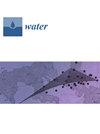The Efficiency of Chemical and Electrochemical Coagulation Methods for Pretreatment of Wastewater from Underground Coal Gasification
IF 3
3区 环境科学与生态学
Q2 ENVIRONMENTAL SCIENCES
引用次数: 0
Abstract
This article compares chemical coagulation with electrocoagulation, two popular methods for the primary treatment of wastewater generated in the process of underground coal gasification (UCG). The primary aim was to determine which method is more effective in the removal of cyanide and sulphide ions, metals and metalloids, as well as organic compounds. In both cases, experiments were conducted in batch 1 dm3 reactors and using iron ions. Four types of coagulants were tested during the chemical coagulation study: FeCl2, FeSO4, Fe2(SO4)3, and FeCl3. In the electrocoagulation experiments, pure iron Armco steel was used to manufacture the sacrificial iron anode. Both processes were tested under a wide range of operating conditions (pH, time, Fe dose) to determine their maximum efficiency for treating UCG wastewater. It was found that, through electrocoagulation, a dose as low as 60 mg Fe/dm3 leads to >60% cyanide reduction and >98% sulphide removal efficiency, while for chemical coagulation, even a dose of 307 mg Fe/dm3 did not achieve more than 24% cyanide ion removal. Moreover, industrial chemical coagulants, especially when used in very high doses, can be a substantial source of cross-contamination with trace elements.化学和电化学混凝法预处理地下煤气化废水的效率
本文比较了化学混凝法和电凝法这两种常用的方法,以对地下煤气化(UCG)过程中产生的废水进行初级处理。主要目的是确定哪种方法能更有效地去除氰化物和硫离子、金属和类金属以及有机化合物。在这两种情况下,实验都是在批量 1 dm3 反应器中进行的,并使用了铁离子。在化学混凝研究中测试了四种混凝剂:FeCl2、FeSO4、Fe2(SO4)3 和 FeCl3。在电凝实验中,使用纯铁 Armco 钢制造牺牲铁阳极。两种工艺都在多种操作条件(pH 值、时间、铁剂量)下进行了测试,以确定其处理铀转化炉废水的最大效率。结果发现,通过电凝,低至 60 mg Fe/dm3 的剂量可实现 >60% 的氰化物还原率和 >98% 的硫化物去除率,而对于化学混凝,即使 307 mg Fe/dm3 的剂量也无法实现超过 24% 的氰化物离子去除率。此外,工业化学混凝剂,尤其是在使用剂量非常大的情况下,可能是微量元素交叉污染的一个重要来源。
本文章由计算机程序翻译,如有差异,请以英文原文为准。
求助全文
约1分钟内获得全文
求助全文
来源期刊

Water
WATER RESOURCES-
CiteScore
5.80
自引率
14.70%
发文量
3491
审稿时长
19.85 days
期刊介绍:
Water (ISSN 2073-4441) is an international and cross-disciplinary scholarly journal covering all aspects of water including water science and technology, and the hydrology, ecology and management of water resources. It publishes regular research papers, critical reviews and short communications, and there is no restriction on the length of the papers. Our aim is to encourage scientists to publish their experimental and theoretical research in as much detail as possible. Full experimental and/or methodical details must be provided for research articles. Computed data or files regarding the full details of the experimental procedure, if unable to be published in a normal way, can be deposited as supplementary material.
 求助内容:
求助内容: 应助结果提醒方式:
应助结果提醒方式:


